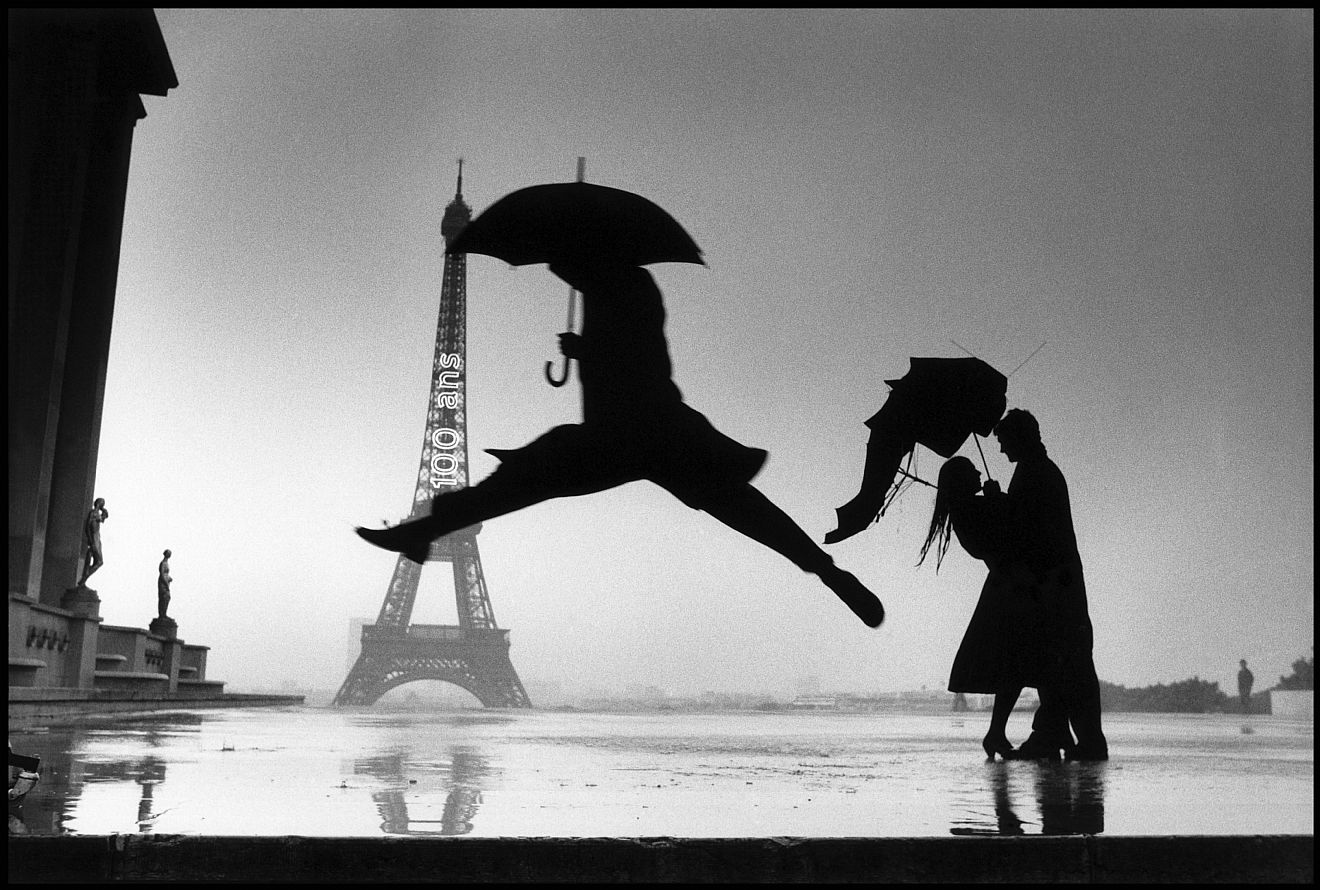(Below written in 1994, transferred to here in 2010: reason explained at the end. Photos are mine except for first one.)
Whenever it comes out in conversation that Scotland is the one place I go on a regular basis, I get a look followed by a question disguised as a comment: “Funny, you don’t look Scottish”, noting my Asian features. So, over the years, I have honed an answer that satisfies most.
I say that I go for the “Ss”: scenery, salmon, solitude, single malts, silence, short-bread, and serenity. And it’s the truth, though not in its entirety. Few wonder why, aside from the alliteration, all the inedible reasons are reflective and solitary. Now, after my last trip, I can tell the full story.
Once upon a time, “Over the Sea to Skye” started, not with the short ferry-ride – now replaced by a bridge — from Kyle of Lochalsh, but on Platform B, Track Two, two hours east in Inverness, the capital of the Highlands.
A noticeable transformation would take place during that train-ride: shoulders would lose their urban tension and brows their work-plowed furrows. Some attributed this magic to a quality in the light that blended lochs, land, and sky into a soothing palette of purple-grays and greens. Others swore it was in the cathedral-clouds contemplated while tea and scones were served on the gently jiggling bone-china. I believed it came from the increasing stillness — palpable even through the window-glass — beckoning with its gift of unobtrusive and undemanding companionship. Whomever was right and to what degree is unimportant: this is how enchantment always began.
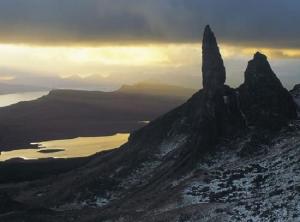
In the year I would turn forty, I was at Inverness Station when I noticed another traveler waiting to commence that journey. She was slender, gloved, and elegantly attired. Her clothes were not only sensible for an outdoor holiday in early May, but also stylish and not particularly Scottish. As she was turned away to read the train-announcement boards, my casual look missed her face, reflecting instead off a cascade of hair the color of the burnished copper-stills at Edradour, my favorite distillery at the time. I felt no disappointment. I already knew extraordinary faces and now avoided them in the same way that a man in a life-raft will yet avoid drinking sea-water. Neither quenches their respective thirsts, and succumbing to either is only a prelude to disaster: ask any survivor. I had no interest in the distraction of even an ordinary face.
I was on my way to Skye for photography, hiking, and a tour of Talisker, whose whiskey Robert Louis Stevenson had described as “ The King o’ drinks”. While these were not necessarily solitary activities, that was how I had wanted them to be on this trip.  Self-employment provided the ability to vagabond away periodically and so, I looked forward to multiple days of absorbing enough of Scotland to last until the next trip. A congenial pub and a long-finish single malt after a day of hill-walking were my only desires, and those would be in abundance on Skye. It was not a tactical retreat to regroup after the last extraordinary face. (For that, I had reread tales of innocence and betrayal while listening to La Traviata and Billie Holiday.) It was a strategic move to smother a pervading loneliness by deliberately being alone, to test the theory that an excess of isolation — like piling more blankets on a feverish body — would break its hold.
Self-employment provided the ability to vagabond away periodically and so, I looked forward to multiple days of absorbing enough of Scotland to last until the next trip. A congenial pub and a long-finish single malt after a day of hill-walking were my only desires, and those would be in abundance on Skye. It was not a tactical retreat to regroup after the last extraordinary face. (For that, I had reread tales of innocence and betrayal while listening to La Traviata and Billie Holiday.) It was a strategic move to smother a pervading loneliness by deliberately being alone, to test the theory that an excess of isolation — like piling more blankets on a feverish body — would break its hold.
My idle glance continued downward to her luggage. Next to a paint-box and travel-easel leaning against her crossed legs was a distinctive piece that converted from backpack-to-roller-to-shoulder bag. It was manufactured by a small company in the Colorado Rockies that prided itself on careful craftsmanship and hi-tech design. I knew this because my own, in a different color, was already on board the train. Bemused by the coincidence, I raised my eyes, caught by the movement of her head turning forward again.
The face was anything but dull, as I should have hoped. The individual features were unremarkable – lightly freckled cheeks, the obligatory eyes, nose, mouth – yet as quickly as my eyes completed a confirming survey and returned to the whole, the sum was still greater than the parts. I was becoming entranced by this pleasing phenomenon when a man crossed between us, his swaying sailor’s gait blinking away the spell.
Re-focusing for a last look, I saw that her attention seemed absorbed by something beyond the luggage carts and schoolboys clustered around a vending machine. Reflexively, I followed her sight-line to see……just the blank far-wall. Swiveling back, curious, I was stunned to recognize in her expression something I couldn’t name, yet feared never finding. Propelled as if by an unseen hand, I rose and found myself, moments later, feather-light standing before her.
The eyes that rose to question the intrusion were not blue…. and I was relieved. Blue eyes had once been pheromonic and inescapable: in their thrall, I would forget that the iris was only a cover, like the atmosphere, over both the wonders and dangers beneath the surface. Blue eyes had not guaranteed more marvels than perils or more brilliance and substance in the inner-person. It had taken a succession of disappointments to inoculate myself against their draw.
These eyes, speckled with shimmering disturbances like the wakes of small boats at sunset, were light-gray. I did not — in fact, could not — look away. And as they drew me in, I felt the same sensation that had enveloped me earlier that week standing at Glenfinnan by Loch Shiel.

Barely past sunrise, I had scanned a landscape without another human being visible yet felt their presence, constant and steady, like the stiff wind hunching low the sparse vegetation. In that glen, with its vista of amphitheater hills sloping down to the water’s surface, Bonnie Prince Charles had waited one August morning in 1745 for the Highland Clans to answer his summons. They came, too few to seed a rebellion, too many to avoid the tears, but just enough for the hope of an independent Scotland to be despair deferred. It was a place where beauty was inter-woven with sorrow for the deaths to come at Culloden the following April. I also knew, then, that she had to be Scottish: she had Glenfinnan eyes.
Without a thought to the consequences — without any thinking – I blurted a line from a movie I had never seen but which now, improbably, emerged from my unconscious as being the only thing to say: “The man you are not waiting for does exist.” and held my breath.
I had flung off my load of blankets and run, naked, into the unknown.
————–
We never made it to Skye.
We missed that train, the one after it, and the one after that.
By the third day we had stopped checking schedules. Or pretending we cared. The decision was effortless, like our connection: we both understood that staying with our respective original plans meant shortchanging them and ourselves. Going then or later didn’t matter: in our state of Grace, Time was not a river taking away unrealized experiences: Time was a pool into which we could dip our hands and have all we needed.
We chose the obvious: an extended “intermission” at a self-catering cottage we found, after a few days of searching, on the shores of Loch Lochy for where to spend her sabbatical. The place had all that mattered: a desk with water-views for me and a large shed with skylights set up as a studio for her. It was the right size for two people who wanted to be together. From there as a base, we could reach even as far as Mallaig and a boat-ride over to Knoydart for hiking.

Chekhov wrote that people who are happy don’t notice whether it’s Summer or Winter. While it’s true that we didn’t care about the condition of the furniture or the water-pressure of the shower, we celebrated how the early cold that year banished the swarms of Summer midges. It meant that we could sit outside late into the evening, as sunset in that latitude was well past 10 p.m. in August.
Stop.
Close your eyes and take a count to ten to recollect a “best day” of your life.
I wager that, whatever the activities or people conjured up, what made it so is that you would change nothing about that day. Close your eyes again and imagine having that “best day of your life” feeling every day.
Now imagine also, in an instant, every day following it be its opposite.
It happened shortly after the daily sun-shower by which, we joked, the village’s clocks –and our post-lunch routine — could be set. I would read on the couch – and invariably surrender to sleep – and she would go to the studio for a few hours. We respected each other’s need to attend to our creative sides, though her results were more evident than mine: a sketch, a small watercolor. (My measure were crossed out words and/or crumpled sheets: there isn’t much difference between writing and procrastinating-from-writing, particularly poetry.)
This day, her back-and-forth between the living area and the kitchen, with the attendant clinking of kitchen utensils and rasping of drawer-slides, had kept me from dozing off completely. I may have mumbled a complaint in half-sleep, because she made a detour: I know that I didn’t dream the weight of her hand on my right-shoulder for balance as she leaned over. Or, more lastingly, the tickle of her breath on my ear whispering: “Sorry, sweetie, just a couple more things for tonight. Go back to sleep. I love you.” I had been pestering her to show me the watercolor – the subject a surprise – she was finishing for my birthday in a couple of weeks, and she had finally agreed to give me a preview that evening.
I woke to the insistent call of a horn, a sound incorporated into a dream of Roland at the Pass in Roncesvalles. Getting up, going outside, and spotting, in the distance, the top of the truck from which it came, took only moments. It was just visible at the last curve and rise of the single-track road on which our grass and gravel driveway fronted. I yelled in the direction of the studio that I was going to have a look, but didn’t get – or expect – an answer: she usually wore headphones while painting, a habit from city-living and neighbors who didn’t share her musical tastes.
As I ran, shouting, the horn stopped and I saw the driver step out of the right side, wave his arms like a man doing jumping-jacks, point to something out of sight in front of the truck and disappear toward it. I remember the unevenness of the gravel through the soles of my sneakers, but not what I was thinking. Approaching, slightly breathless from that 70-plus yard run, I saw one of our rented Raleigh bikes and felt the nausea at the same time.
Even before reaching her, I knew by the driver’s babbling that it was too late: there was too much red on the road, and too much stillness. Reliving those next minutes, hours and days is a return dive into a world of numbness and blurred images.
The inquest was, mercifully, brief, as was the subsequent trial: though the curve was old, the road was wet and the lorry-driver new and “high”. It was surmised that the weight and sway of the two wine-bottles in the string-bag hanging on the bicycle’s handlebars had unbalanced it as she swerved to avoid the oncoming — and speeding — truck. As she skidded on the loose stones, it was just Fate that both had turned in the same direction. And that wearing a helmet was not our habit in Scotland. The mittens – the mid-November Highland weather had finally turned wintry – probably didn’t help her grip on the bicycle’s handles.
I thought I’d care about the verdict, but all the fury was gone by that point, along with every other feeling. I kept the bicycle’s basket in the basement of my house in Philadelphia until her red had faded enough to blend with the peonies she once had painted on its sides. I measured my recovery by how often I checked and then somnambulated through the next two years as the the line “… the thing strongly seized has turned to dust / and darkness takes my heart..” from a Conrad Aiken poem became an unwelcomed earworm.
Last year, returning to a beach near Gairloch, I placed the basket in a pyre and watched its sparks and embers dance Skye-ward and toward the stars, then waited for the ashes to wash West with the tide.
The watercolor, I finally framed and hung, the rainbow colors of the hand-loomed silk scarf I had given her having passed from partly-filled promises to becoming a testament for those that had been. Sometimes, as I rush pass it on the way out the door and catch my reflection on the glass, I am, once again, on a train to Inverness Station.

For Helen, I had held my breath for seven months, two weeks, and four days.
October 19, 1994
Tibetan monks spend months painstakingly placing each grain of sand in its predestined place to create their dazzling Mandalas, a tribute to and lesson about patience, beauty, and impermanence.
The years (1992-1994) it took me to select and re-select the words for the account above made it both my personal Mandala and an act of faithfulness to and meditation on the memory of a time and happiness that was too perfect to last. The process and the time spent were therapeutic and cathartic. Or, as Michael Cunningham put it in “The Hours”, his novel – and novel “take” – on Virginia Woolf’s “Mrs. Dalloway”:
“It had seemed like the beginning of happiness, and (one) is still sometimes shocked, more than thirty years later to realize that it was happiness… There is still that singular perfection, and it’s perfect in part because it seemed, at the time, so clearly to promise more. Now (one) knows: That was the moment, right then.”
“Facts”, I once wrote in a poem, are “….fish with hooks already in their mouths…” Writing this served – unwittingly and unexpectedly – as a study on the timelessness and power of emotional memory, my own naïveté about its effect, and the unintended consequences of personal exploration via story-telling. My fish all swam toward the same truths: unexpected love encountered, lost, and mourned.
Some drink to drown them, but my sorrows (unlike me) are great swimmers. What had started as a straightforward travel account with a Scottish setting, was hijacked by what was really on my mind (and heart) at the time. Eventually, I recognized that this was actually a gift and gave it free rein.
My great love for Scotland, grown from a friendship with Andy Turnbull that started during his year in the USA during college and countless trips over decades, formed an inexplicable soul-level connection to the pained, the beautiful Highlands, and that love was being returned by it in this form: as the setting – comforting, familiar, immutable – through which to deal with a loss that took place an ocean away from there, on domestic shores.
Thus, every photo, word, and sentiment about Scotland and its history and landscape is factual and true, as are the scarf, the watercolor, my long-ago love for the red-haired artist from Montana, the duration of the relationship, and my then-shattered heart from a broken engagement …. but no one died, though the loss was a living death for many years. Mourning the living dead is harder than mourning the dead dead.
Lastly, but importantly – hough it doesn’t really need saying – the death of a character is a literary device, NOT a sign/wish for actually wanting them dead! Quite the contrary, I know that she is alive – and, hope, happy because that’s what one would want for someone – anyone – once loved.
I was the fool: the passion and sureness about our coupe de foudre love, shaken by her fears, was overwhelmed by my fear of loss, ultimately causing the loss. A story for another time but a lesson learned at great cost. It’s why it took years for that fire to ember into that quote from “The Hours”.
This Yehuda Amichai poem (link to its place in my personal anthology of love poetry) best describes its legacy:
Once A Great Love
Once a great love cut my life in two.
The first part goes on twisting
at some other place like a snake cut in two.
The passing years have calmed me
and brought healing to my heart and rest to my eyes.
And I’m like someone standing in the Judean desert, looking at a sign:
‘Sea Level’
He cannot see the sea, but he knows.
Thus I remember your face everywhere
at your ‘face Level.’
———————————————————-
I have transferred the story to this blog, as the fire of December last that destroyed my apartment has made me want to find safe, non-physical spaces for those items that survived it.
April 5, 2011








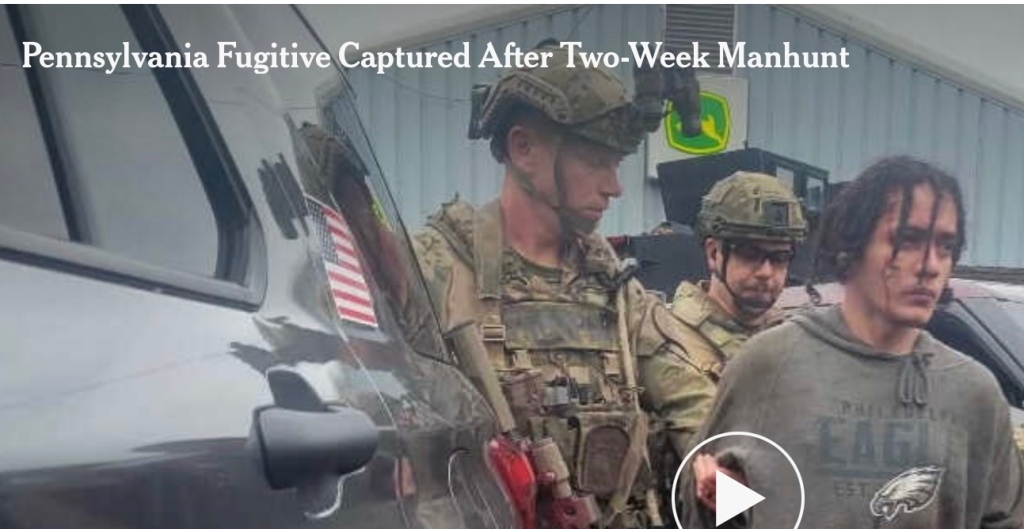

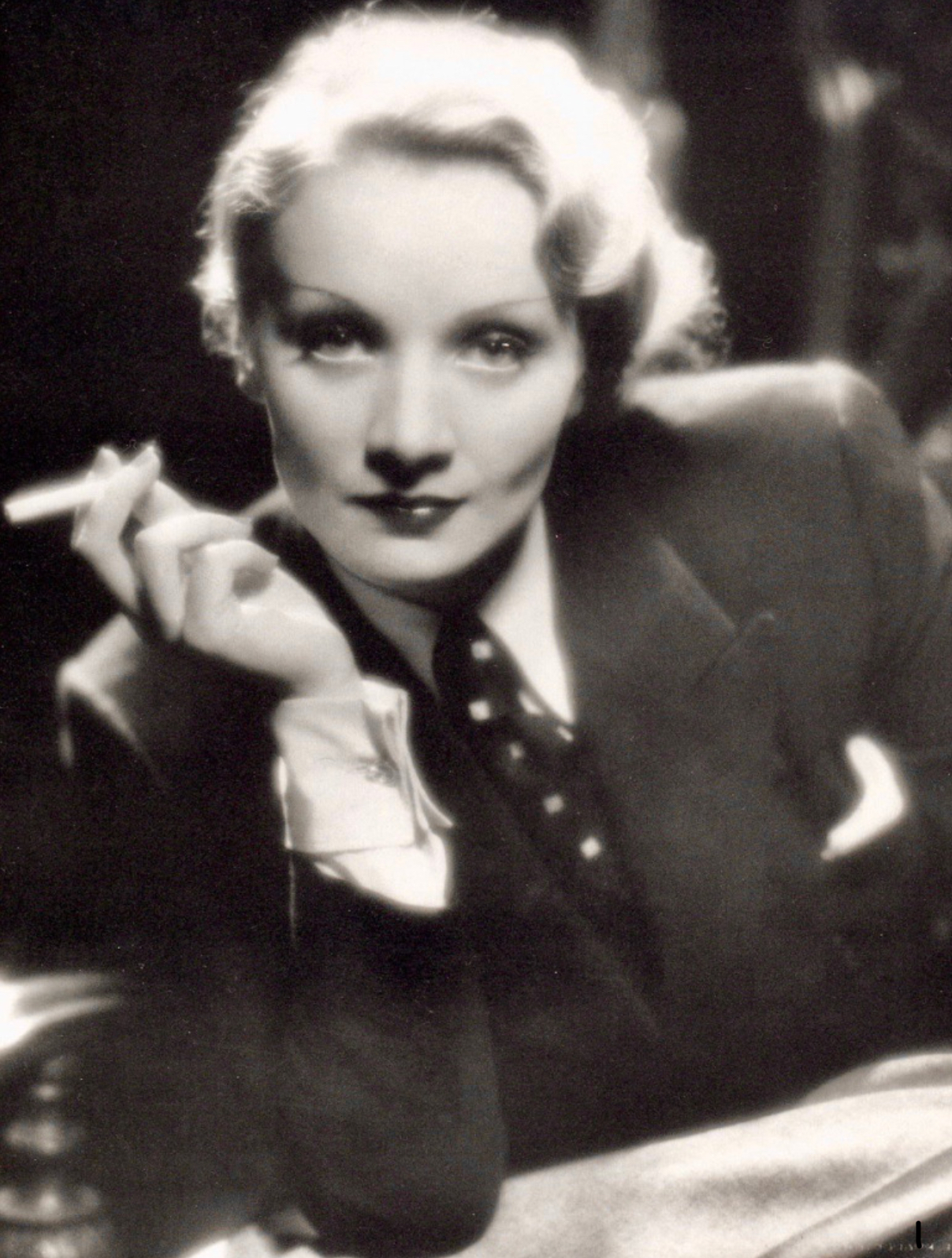

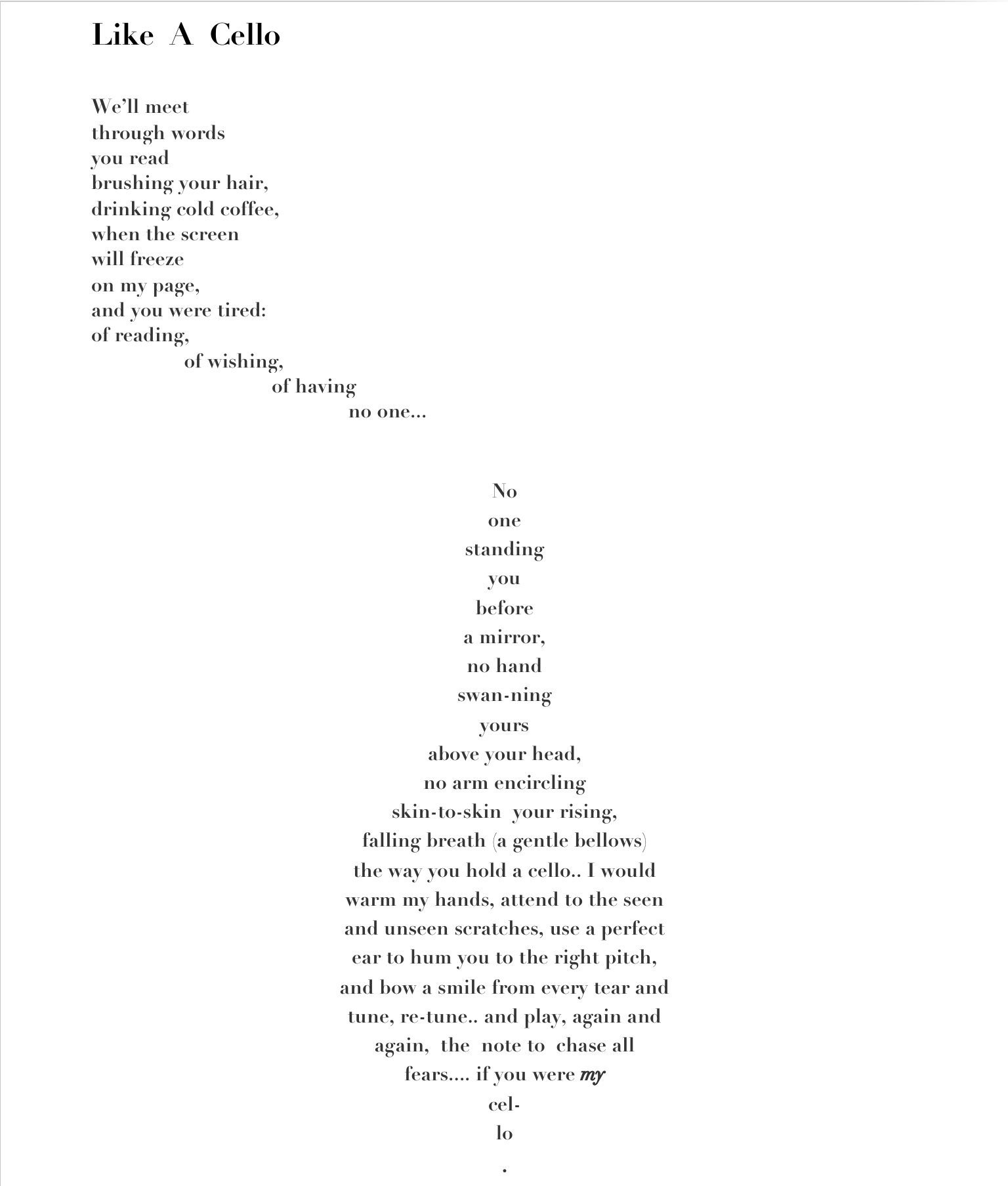

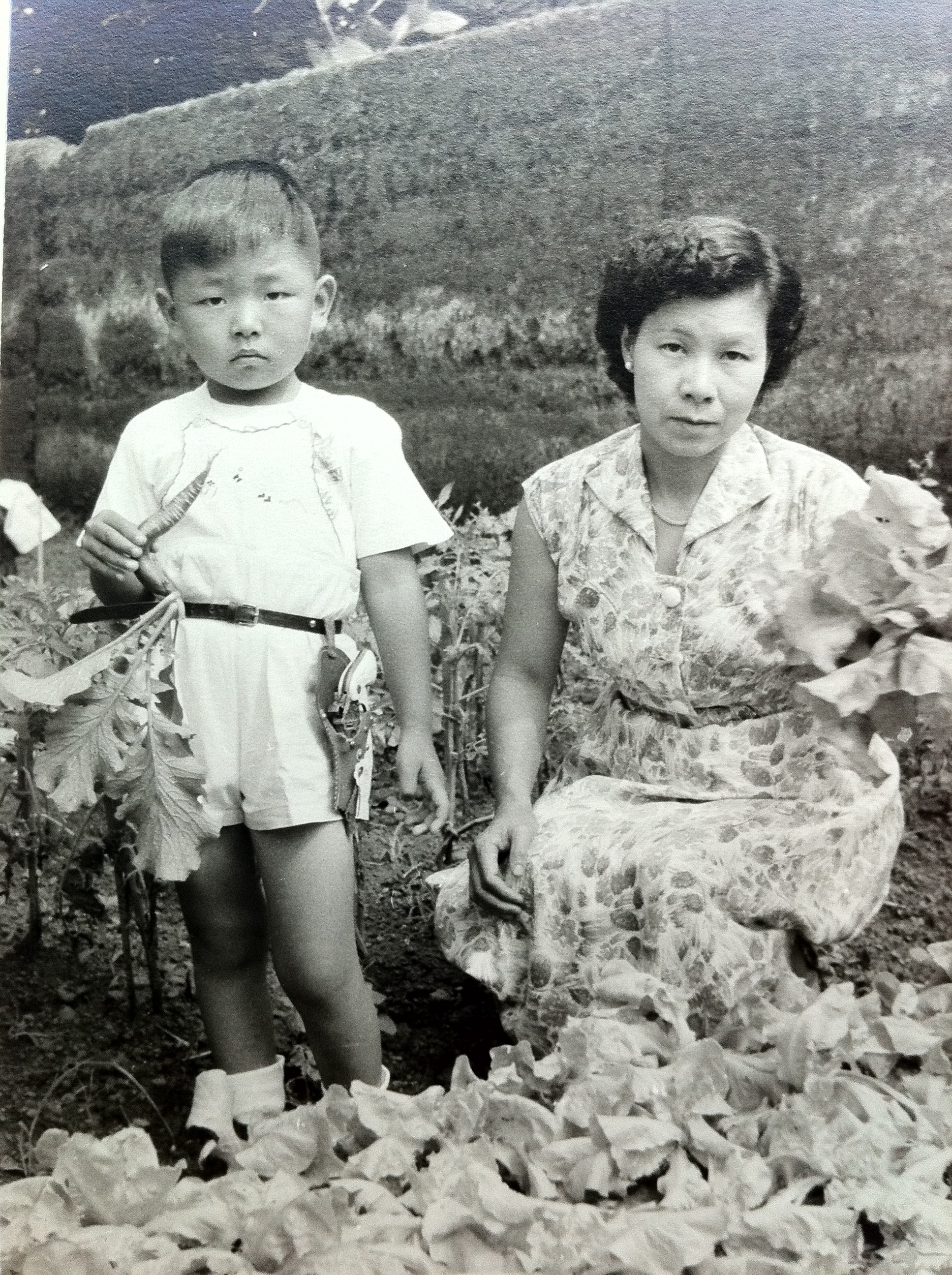 interrogated about a neighbor’s milk money missing from their porch, and brow-beaten into a false confession.
interrogated about a neighbor’s milk money missing from their porch, and brow-beaten into a false confession.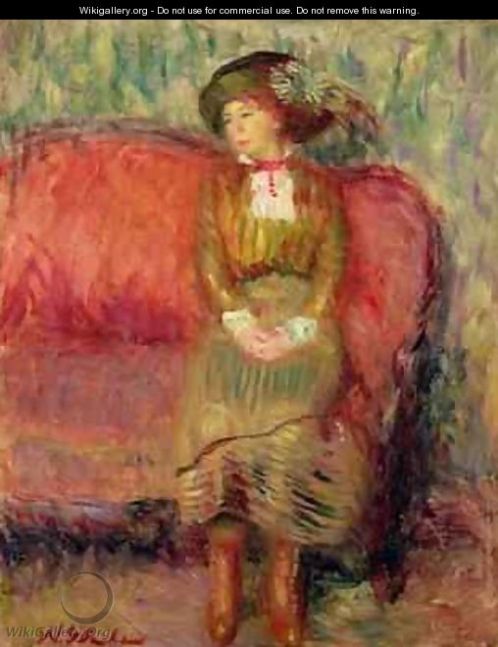

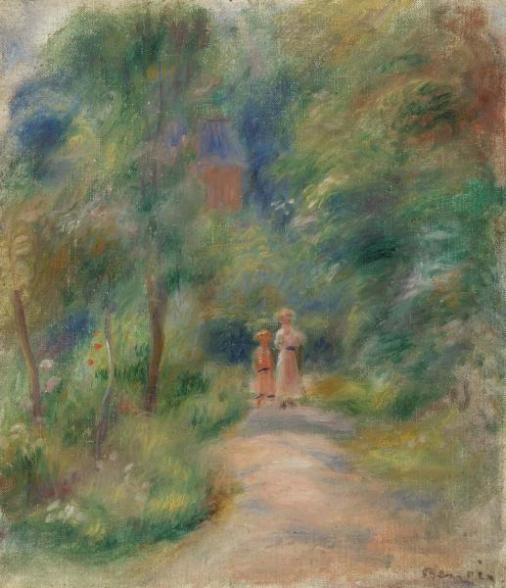





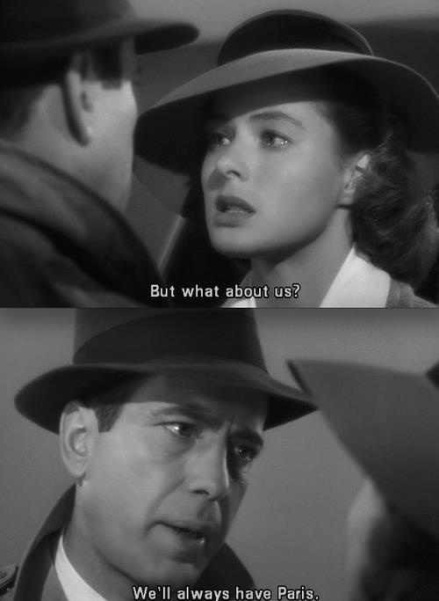
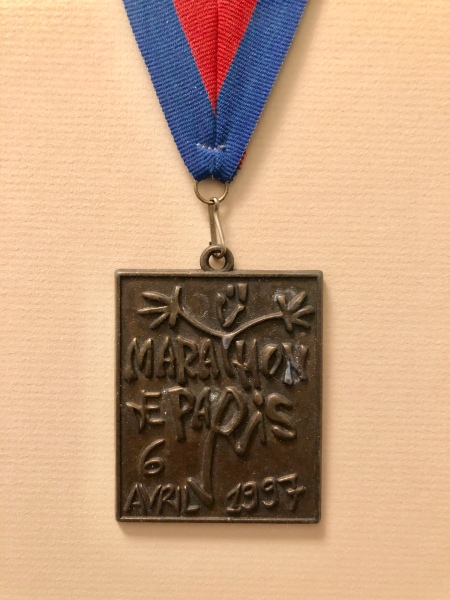 Once is not enough. Or even my dozen-plus times.
Once is not enough. Or even my dozen-plus times. there is a segment in which a senior editor, a former model herself, is followed around Paris scouting locations for a photo-shoot. As the chauffeured car meanders the streets, the camera never leaves her face. We note – in her half-smile, a curtailed sentence, a tear squinted back – not the memories themselves, but their revelatory bubbles, hints of her private Paris.
there is a segment in which a senior editor, a former model herself, is followed around Paris scouting locations for a photo-shoot. As the chauffeured car meanders the streets, the camera never leaves her face. We note – in her half-smile, a curtailed sentence, a tear squinted back – not the memories themselves, but their revelatory bubbles, hints of her private Paris.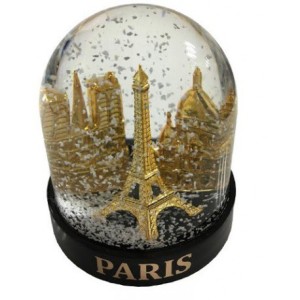
 Over the years, as the occurrences increase in number and variety, the bits and pieces – from the iconic to the obscure, added deliberately or by chance – shape that layer’s complexity and topography. We note the reverence, the wistful tone, the sigh (or silence), the distant (or knowing) look of a shared secret in the eyes of those who have experienced it. It’s a Paris where history and fiction mix and stroll together, where little Madeline dances Gershwin with Gene Kelly, Curious George climbs La Tour Eiffel, The Three Musketeers charge the barricades, and Napoleon applauds Piaf singing Non, je ne regretted rien (“No, I regret nothing.”)
Over the years, as the occurrences increase in number and variety, the bits and pieces – from the iconic to the obscure, added deliberately or by chance – shape that layer’s complexity and topography. We note the reverence, the wistful tone, the sigh (or silence), the distant (or knowing) look of a shared secret in the eyes of those who have experienced it. It’s a Paris where history and fiction mix and stroll together, where little Madeline dances Gershwin with Gene Kelly, Curious George climbs La Tour Eiffel, The Three Musketeers charge the barricades, and Napoleon applauds Piaf singing Non, je ne regretted rien (“No, I regret nothing.”) 